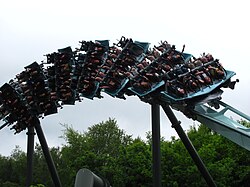Flying roller coaster
| Flying roller coaster | |
|---|---|

Galactica, a flying coaster at Alton Towers navigating the 'Fly-to-Lie' inversion.
|
|
| Status | In Production |
| First manufactured | 1997 |
| No. of installations | 26 |
| Manufacturers | Bolliger & Mabillard (2002-), Vekoma (2000-), Zamperla (2002-) |
| Restraint Style | Over-the-shoulder (most common style) |
A flying roller coaster is a type of roller coaster meant to simulate the sensations of flight by harnessing riders in a prone position during the duration of the ride. The roller coaster cars are suspended below the track, with riders secured such that their backs are parallel to the track. Flying roller coasters come in a variety of sizes and designs depending on the intended demographic for the ride. Some flying roller coasters are intended for children and, thus, are relatively slow and gentle; others are meant for older children and adults and can be very fast and intense.
The flying roller coaster is a relatively new concept. The world's first flying roller coaster was Skytrak Total, built in Manchester, United Kingdom at the Granada Studios Tour in 1997. The Skytrak used a single-passenger car. Riders would climb into the car in much the same fashion as climbing a ladder, then the car would be raised up to the track before being dispatched. The single-passenger design kept the ride's capacity low, at only 240 riders per hour. The park, and Skytrak itself, were short-lived; both closed in 1998.
Dutch roller coaster manufacturer Vekoma constructed the first large-scale flying roller coaster, Stealth, for California's Great America in 2000. Nicknamed the 'Flying Dutchman' by Vekoma, Stealth featured a higher-capacity train with four-across seating. Riders load the trains in an upright sitting position, facing the rear of the train. After the train is fully loaded, a mechanism in the station lower the seats to the track, with the riders on their backs facing the ceiling. After cresting the lift hill, the track twists 180 degrees to flip the riders into the flying position for the rest of the ride. Just prior to reaching the roller coaster's final brake run, the track twists again, such that riders are lying on their backs facing upward. After reaching the station, the seats are raised back to loading position.
The harness system for the Vekoma flying roller coaster consists of two main elements: the lap bar and the chest harness. After being seated, the operator pulls down the lap bar, which is hinged on the floor of the train. The bar locks into slots in the sides of the seat and secures the waist. Halfway up the bar is a pair of leg restraints, which hold the legs in place during the ride. The rider then fastens the buckles to close the chest harness and secure the upper body. Hand grips are placed at the ends of the arm rests of each seat. Vekoma would expand upon the 'Flying Dutchman' prototype with two other installations in 2001, Batwing for Six Flags America and X-Flight for Geauga Lake. Of the three Vekoma Flying Dutchmans, only Batwing still operates at its original location: X-Flight now operates at Kings Island as Firehawk, while Stealth was relocated to Carowinds and renamed BORG Assimilator from 2004 to 2007, and now operates as Nighthawk.
...
Wikipedia
